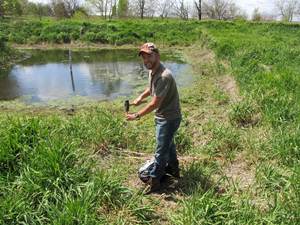Advancing constructed wetlands and denitrifying bioreactors to abate edge-of field nitrogen losses
Effectiveness of constructed wetlands in reducing nitrogen and phosphorus export from agricultural tile drainage
Situation: In the Midwest, agriculture contributes large amounts of nitrogen (N) and phosphorus (P) to surface waters. These excess nutrients reduce groundwater and surface water quality as well as contribute to hypoxia in the Gulf of Mexico. The use of constructed wetlands can reduce the amount of nutrients begin carried from agricultural runoff into surrounding waters.
Actions: Researchers from the University of Illinois assessed the effectiveness of three constructed wetlands to remove N and P from subsurface tile drainage water from an agricultural system. The study was conducted over a three-year period.
Take-home message: 
- Nitrate-N removal efficiency by the constructed wetlands over 3 years was 37%.
- Adding a buffer strip between the wetlands and the river increased nitrate-N removal efficiency to 46%.
- Total P removal efficiency by wetlands over 3 years was only 2% and was highly variable between wetlands and years.
- Constructed wetlands can be an effective tool for removing nitrate-N from agricultural runoff.
For more information:
- Kovacic, D.A., M.B. David, L.E. Gentry, K.M. Starks, and R.A. Cooke. 2000. Effectiveness of constructed wetlands in reducing nitrogen and phosphorus export from agricultural tile drainage. Journal of Environmental Quality (29): 1262-1274.
- Email David Kovacic at dkovacic@uiuc.edu or Mark David at mbdavid@illinois.edu